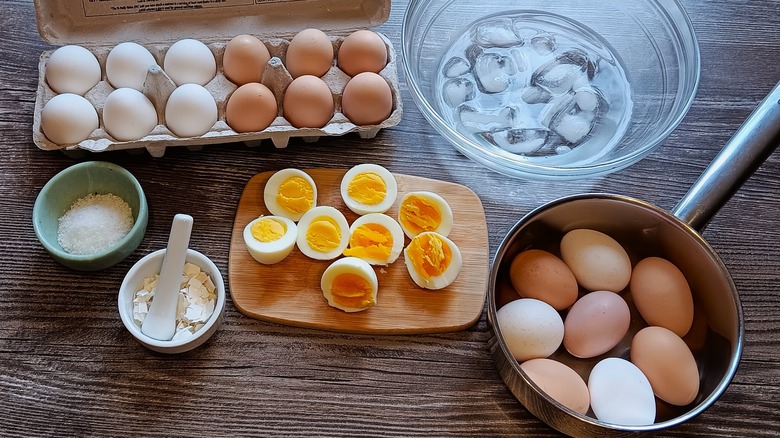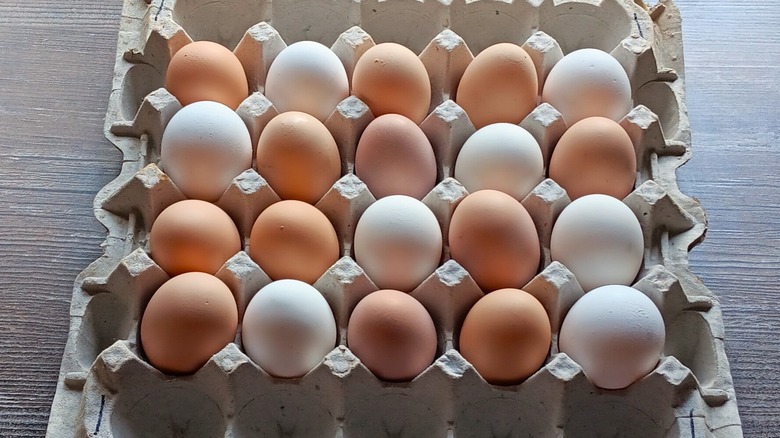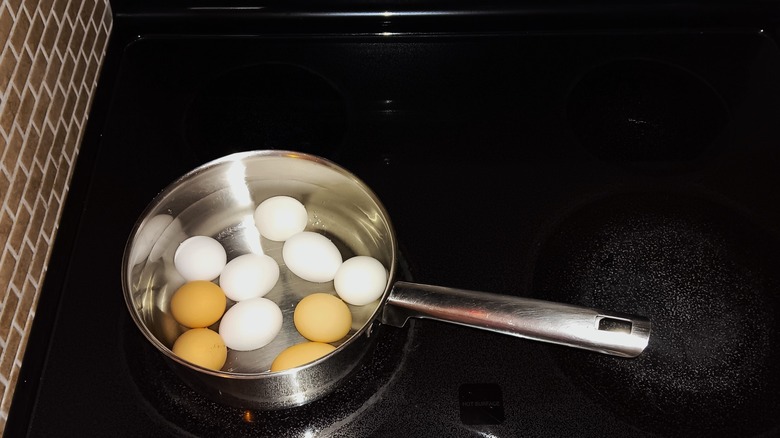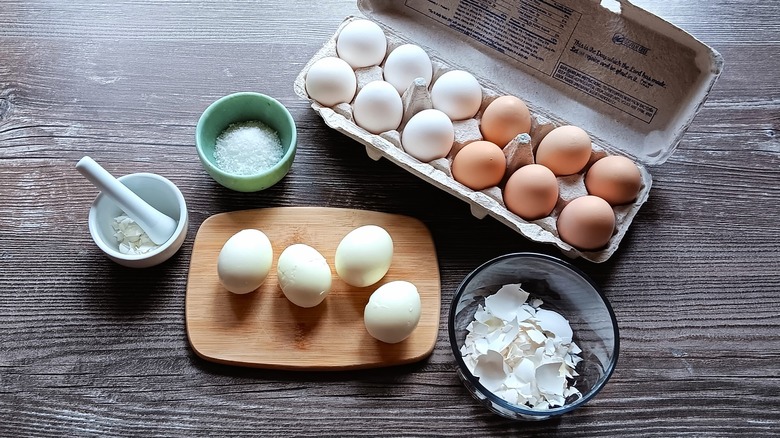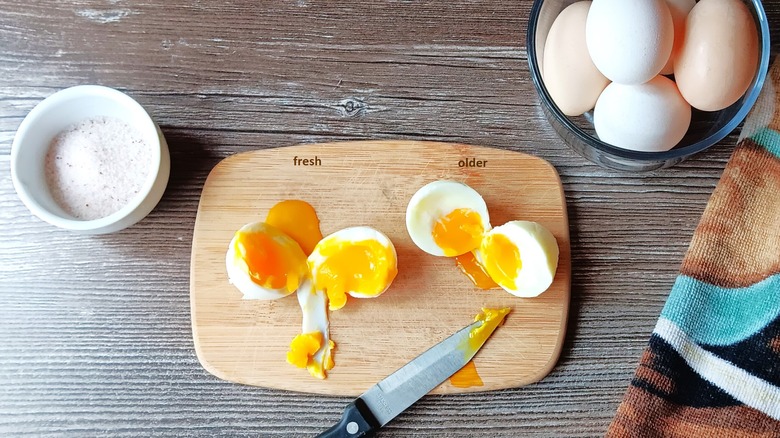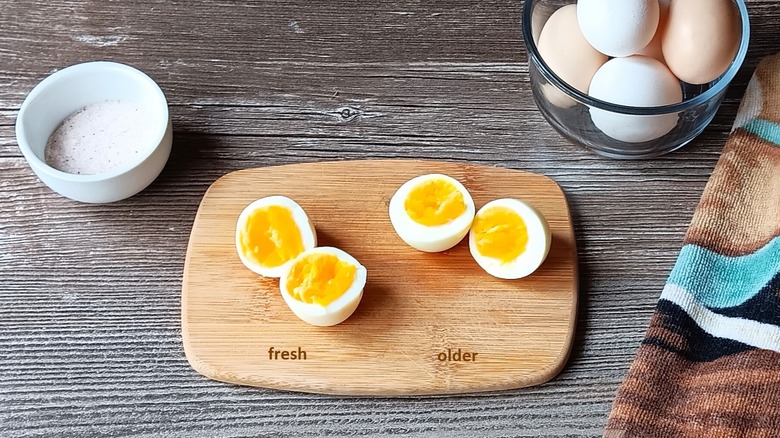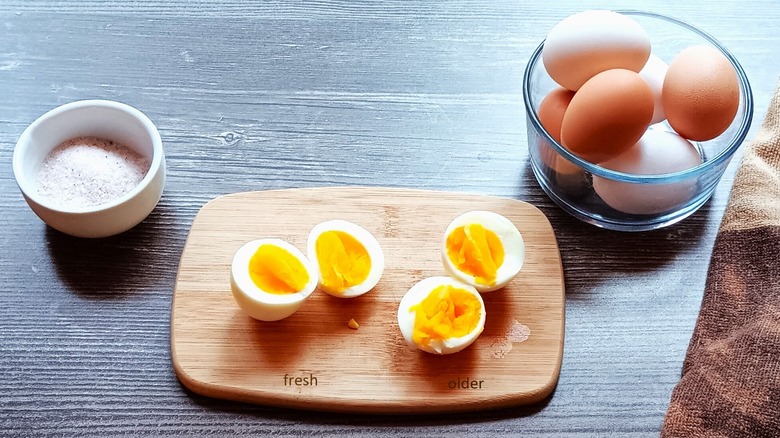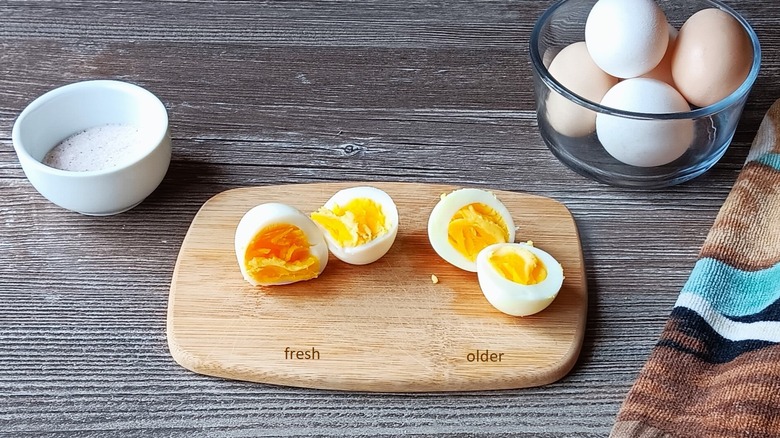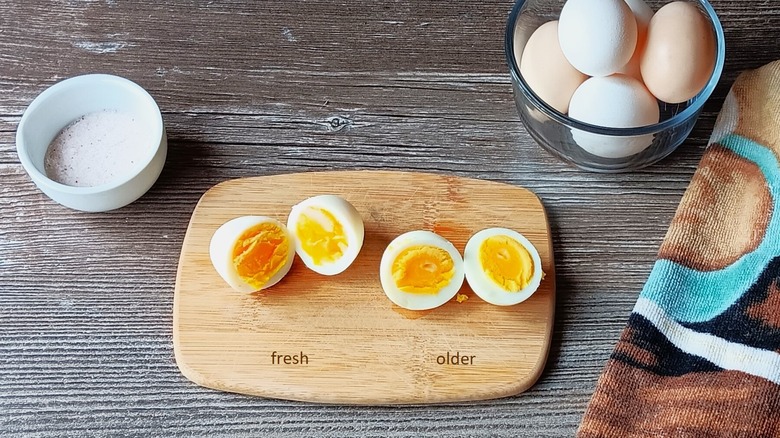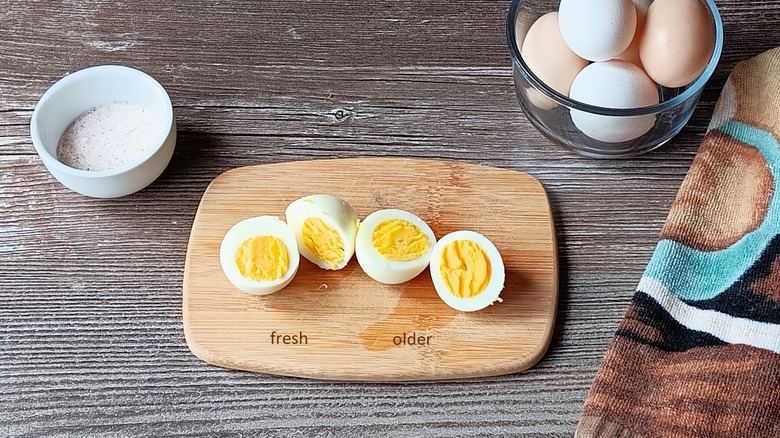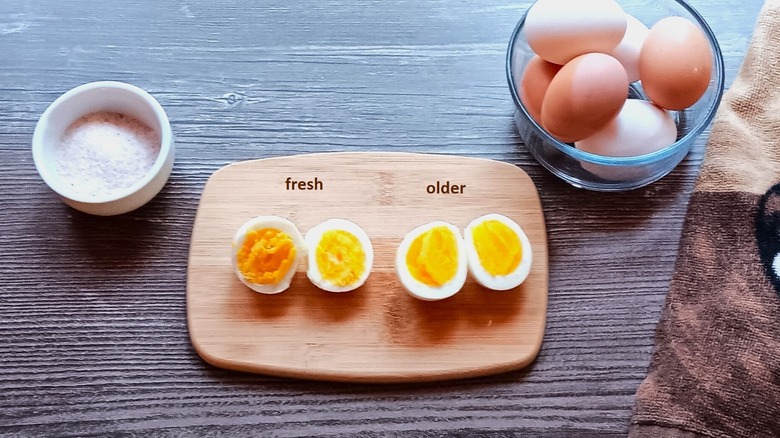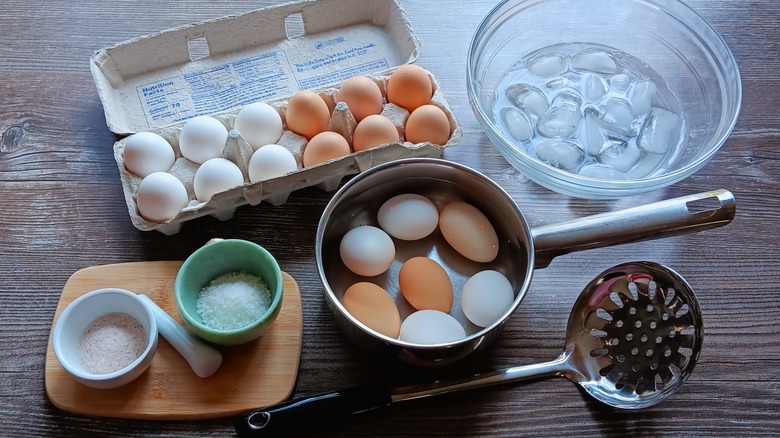Your Ultimate Guide For Boiled Eggs With The Yolk Texture You Want
Anyone can boil eggs, but getting the yolk just the way you want it requires a bit of precision. We're not going to tell you this basic culinary skill is difficult, but boiling eggs is a skill that goes beyond haphazardly plopping eggs in a pot of water, turning on the stovetop, and letting them rumble away in hot water for an undetermined amount of time.
Achieving a specific texture to your yolk takes a little forethought and some patience. From runny, soft-boiled eggs to dry, hard-boiled eggs, there's a range of doneness that can either make you swoon in tasteful delight, or swear boiled eggs are not worthy of another bite. You can even eggsperiment (see what we did there?) with different egg varieties: hen, duck, quail, goose, turkey, or ostrich; all of which invite your taste buds to explore richer, creamier, and more decadent yolks.
Personal preference aside, yolk texture matters if you're working with a recipe. You don't want a soft, liquid yolk for egg salad or a dry, hard yolk for dipping toast points or bacon pieces. For that reason, we put together the ultimate guide for boiled eggs so you end up with the yolk texture you want. To aid us in providing the most accurate information, we boiled dozens of eggs using the most popular methods while making some comparisons along the way. The results are eggciting.
Choosing the right egg for boiling
It all begins with choosing the best type of egg to boil. More than likely, the eggs in your fridge or hanging out on your counter came from a hen — and for the sake of this guide, we used hen eggs to determine the right amount of timing for soft, medium, and hard-boiled eggs.
Though it's often noted you should use older eggs when boiling them (because peeling can be a pain otherwise), we decided to do a side-by-side of fresh farm eggs (the roosters wake this writer every morning) and store-bought eggs to note any difference between just-laid and laid-awhile-ago eggs. It's also recommended by chefs to start with eggs that are at room temperature as opposed to straight out of the fridge. We opted to try out both for the store-bought eggs.
Whether the egg is fresh or store-bought or from a hen or ostrich, the size also should be considered since it can affect cooking time. Eggs range anywhere from small to extra large, which gives the cook differing times to yield a specific yolk texture. This is important to keep in mind with fresh eggs — sourcing locally usually means receiving whatever size the local hens happen to lay. For this guide, we boiled small-to-medium size eggs.
The best method for boiling eggs
Professionally trained chefs are taught in culinary school to add room-temperature eggs to boiling water and continuously boil them for a desired amount of time to achieve boiled egg perfection. Another popular method for boiling eggs that's used among chefs requires bringing the water to a boil with the eggs already in the pot. Then the eggs are removed from the heat source, remaining covered, for a desired amount of time.
You don't need to stick to boiling water on the stovetop, however, to make a hard-boiled egg. Some ways to cook a hard-boiled egg include the oven, an air fryer, an instant pot, or even the microwave. While there are positives and negatives for boiling eggs in many different ways, for this guide, we used the method of cooking in standing hot water.
Place room temperature or cold eggs in a pot with enough room for them to roll around a little. As with cooking most foods in a pot or pan, you don't want to overcrowd the food. Fill the pot with fresh cool water so it just covers the eggs, about a half-inch to an inch. Cover the pot, and bring the water to a boil. Keep the pot covered and remove it from the heat. Begin your timer. The time ends when the eggs are plunged into an ice bath.
Peeling boiled eggs
Very few people like to peel boiled eggs. Because it can be such a tedious task, there are numerous tips for peeling hard-boiled eggs. From poking holes in the shell before cooking to adding vinegar to the water for boiling, egg lovers debate about the best process. The method we like best, and one that's popular, is shocking the boiled eggs in ice water to stop the cooking process. This action also forces the membrane to pull away from the egg, which creates a small air pocket, making it easier to peel.
Experience has shown us that peeling older, boiled eggs is easier than with fresh eggs. But the only real difficulty we had with peeling boiled eggs for this guide was with the soft-boiled time of 3 minutes, all varieties.
When you're able to flawlessly peel your boiled eggs, save the shell. Clean, cooked eggshells can be used for a variety of applications, from supplemental to ornamental. Used for cleaning pots, feeding chickens, enriching the soil, and adding to coffee grounds: You should probably stop throwing out eggshells.
3 minutes
A soft-boiled egg is sometimes thought of as fancier than a hard-boiled egg. Perhaps it's because creating that perfect, warm, melt-in-your-mouth balance of creamy, custardy white and rich, runny yolk can be a bit intimidating. But a soft-boiled egg doesn't have to be difficult to master.
The most common cooking time for the perfect soft-boiled egg is 3 minutes using the standing hot water method. Start the timer immediately after the water has risen to a boil, remove the pot from the heat, and stop as soon as the egg is placed in an ice bath to halt the cooking.
Having always believed older eggs are better for any type of boiled egg, we were delighted to enjoy one of the best soft-boiled eggs we've ever had with a fresh farm hen egg. The older, store-bought soft-boiled egg also hit the spot with a creamy, runny yolk but the white had slightly more chew to it. There was also a lot more white than yolk. The fresh soft-boiled egg simply melted in the mouth with no chewing needed. Luxurious indeed.
There was no notable difference between the room temperature or cold store-bought eggs. The soft-boiled results for both older eggs were similar. But both the fresh and older eggs were difficult to peel, even with an ice bath.
6 minutes
The 6-minute egg is often considered a soft-boiled egg because it has a slightly liquid, jammy center. Typically exhibiting a gooey yolk and solid, but soft, white, the 6-minute egg is pretty popular. Our 6-minute room-temperature fresh and older eggs were closer to soft to medium-boiled, featuring yolks that had a thick nut butter texture. The older eggs that we cooked straight from the fridge had a pudding-like yolk, which was delicious.
Whether or not you consider the 6-minute egg to be soft- or medium-boiled, since boiling eggs can give you a different yolk in a matter of seconds, you may need to play around to find the exact texture you like.
Jammy eggs make a welcome addition to several recipes but of course, you can just eat the egg with a touch of salt and enjoy the egg in all its splendor. But consider topping your next salad, steak, or noodles with a soft- to medium-boiled egg. The yolk acts as a saucy spread that complements a wide variety of foods.
8 minutes
Depending on who you talk to, the 8-minute egg might be referred to as a medium-boiled egg or a hard-boiled egg. Technically, a medium-boiled egg has a yolk that's still on the liquid side, while the hard-boiled egg is fairly solid where the yolk is noticeably cooked through. But there's a sweet spot between the two that could be referred to as medium- to hard-boiled. This creates another kind of bite to the yolk — a feel that's not pudding- or jam-like, but also not dense or dry either.
Whatever you want to call it, the 8-minute egg results in one of our favorite ways to eat a boiled egg. At 8 minutes, we get an egg that has a velvety, creamy, but cooked, yolk that resembles cheesecake with its light and fluffy, almost whipped consistency. The white of the egg is also soft but has a tender bite. The two qualities go together like chocolate and peanut butter; it creates an overall culinary experience you want to repeat.
In this session of boiling eggs, we didn't notice much textural difference between the fresh and older boiled eggs, either room temperature or cold. But certainly, the fresh eggs hold more flavor.
10 minutes
Usually considered to be a hard-boiled egg, the 10-minute egg borders on medium since it's still on the softer side of boiled. Depending on your personal results boiling an egg for 10 minutes, the egg may be too soft to be considered for a dish like egg salad but it's still a great option for deviled eggs. The yolk is soft and pliable to aid in making a creamier deviled filling. And who doesn't like a good, deviled egg? To get you started, check out our easy deviled eggs recipe.
For this guide to boiled eggs, our testing of fresh, room-temperature eggs at 10 minutes resulted in just that — a softer hard-boiled egg that could transform into a creamy, delectable, deviled egg. The older, room-temperature boiled egg cooked a little bit more and featured a chewier egg white and drier yolk. The cold, older egg that was boiled for 10 minutes didn't cook as much, which resulted in the white being more tender, with a yolk that was gummy.
12 minutes
Firmly in the hard-boiled egg category, the 12-minute egg is completely cooked through and often purported to be the right amount of time for the perfect hard-boiled egg. But we would suggest that the perfect hard-boiled egg is subjective and reliant on personal tastes. Twelve minutes of cooking results in a tender bite of egg white and a slightly crumbly yolk that has the texture of paste, making this ideal for any dish that calls for cutting the boiled egg into chunks.
Our fresh hen eggs cooked for 12 minutes gave us an almost chewy and disappointingly dry yolk, though the white was decent enough. The older, store-bought egg, however, was the epitome of a hard-boiled egg; the white of the egg had a tender bite while the yolk was somewhat dense, with a balance of moisture so it didn't fall to pieces; these eggs turned into an egg salad.
15 minutes
Qualifying as a hard-boiled egg, some might argue that 15 minutes is far too long to boil an egg. Using the standing hot water method, 15 minutes isn't out of the question for getting a really good hard-boiled egg, but you do run the risk of the yolk drying out. If you prefer a more crumbly yolk with a dense white, then 15 minutes may be your mark.
In our test kitchen of boiling eggs, the fresh and older eggs that were placed in the pot of water at room temperature were overcooked. The results were a chewy white with a very dry yolk that required mouthfuls of water to wash down. The older egg that was cooked from the cold temperature of the fridge fared better, though it was still a bit overcooked. We would say that 15 minutes is probably too long in most cases of hard-boiled eggs but could be salvaged with the right recipe, preferably one that has added moisture like mayonnaise or mustard.
Uh-oh, I forgot the eggs
It happens to the best of us. You start the process of boiling eggs and get sidetracked (thankfully the heat source is off). The next thing you know, the eggs have been cooking in hot water for 30 minutes. Can you still eat them? What happens if you overcook hard-boiled eggs? Aside from the unappealing nature of overcooked boiled eggs, which can lead to a gray or green ring or hue around the yolk, you can still eat them. But overdone eggs are not the result you're looking for.
We left eggs sitting in the pot of hot water for 30 minutes. Normally, overcooked eggs present off-putting colors, but these eggs almost looked like they survived a grueling hot water soak by deepening in color. In this case, looks were deceiving. The egg yolks were dry like chalk while the whites were rubbery and chewy. They even tasted overcooked, on the verge of burnt.
Methodology
For your ultimate guide for boiled eggs with the yolk texture you want, we put fresh hen eggs (laid within the week of cooking) up against older eggs (bought from the store a week prior to cooking) and boiled them for set times to achieve everything from soft-boiled to uh-oh-they're-overdone. Though boiling eggs is typically broken down into soft-, medium-, and hard-boiled, we went a step further and included four more yolk textures.
On an electric range and using the method of cooking eggs in standing hot water after bringing them to a boil, we cooked the room-temperature fresh and older eggs together. The cold older eggs were done separately. Fresh and older eggs were removed from the pot of hot water at designated times: 3, 6, 8, 10, 12, 15, and 30 minutes, and placed into a bowl of ice water for a few minutes. Eggs were peeled as soon as they were cool enough to touch, which was shortly after the ice bath.
